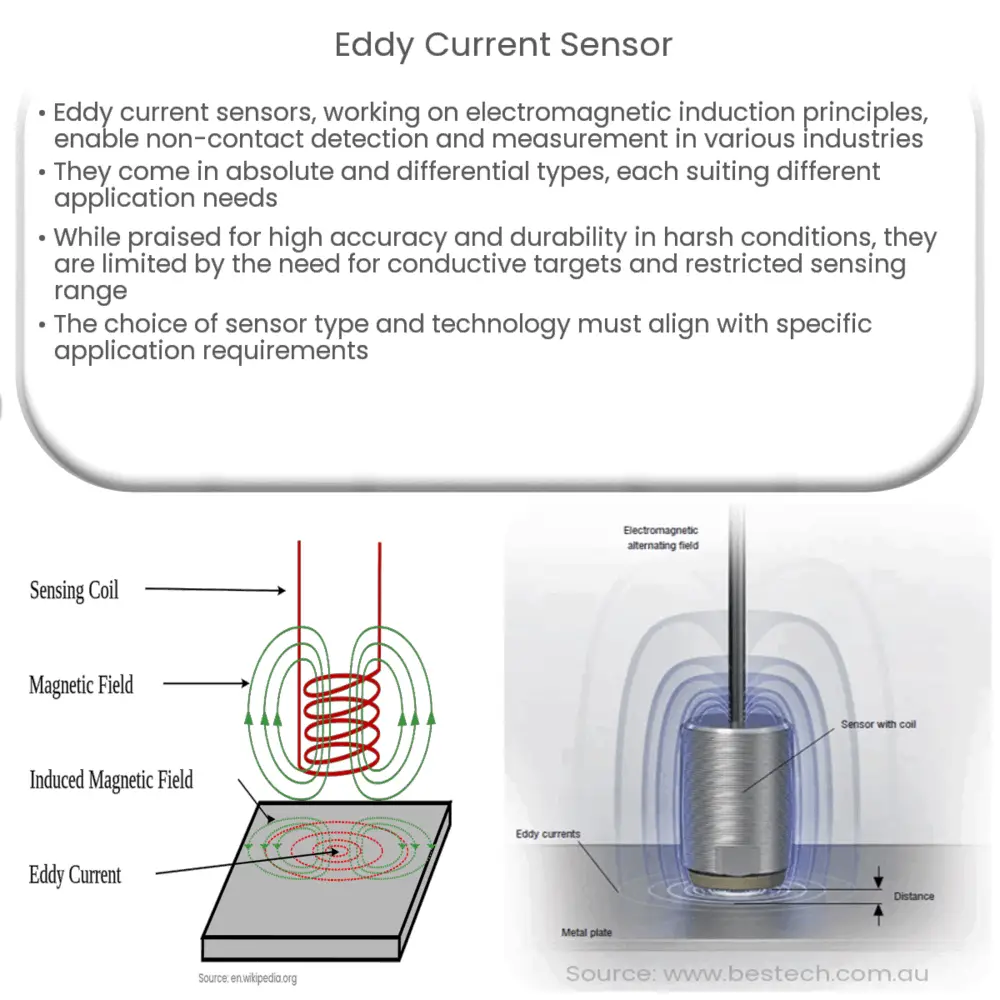Eddy current sensors are non-contact devices used to detect and measure conductive target position changes with high accuracy, reliability, and durability in various industries.

Eddy Current Sensor: An Overview
Introduction
Eddy current sensors are non-contact devices that detect and measure changes in the position of a conductive target. These sensors are widely used in various industries, such as automotive, aerospace, and manufacturing, due to their high accuracy, reliability, and ability to operate in harsh environments. In this article, we will explore the working principle, types, and applications of eddy current sensors.
Working Principle
Eddy current sensors operate based on the principles of electromagnetic induction. When a coil of wire is energized with alternating current (AC), it generates an alternating magnetic field around it. If a conductive material is brought near this magnetic field, eddy currents are induced within the material. These eddy currents generate their own magnetic fields, which interact with the primary magnetic field produced by the coil, causing a change in the coil’s impedance.
The sensor’s electronics continuously monitor these changes in impedance and convert them into an electrical signal proportional to the distance between the sensor and the target. This allows for precise measurement of the target’s position without any physical contact, making eddy current sensors ideal for applications where contact-based sensing methods are not suitable.
Types of Eddy Current Sensors
There are two main types of eddy current sensors: absolute and differential. The choice between these two types depends on the application requirements and desired level of measurement accuracy.
Absolute Eddy Current Sensors
Absolute eddy current sensors use a single coil to measure the distance between the sensor and the target. The output signal from the sensor is directly proportional to the target’s position. These sensors are relatively simple in design and are suitable for applications that require moderate levels of accuracy.
Differential Eddy Current Sensors
Differential eddy current sensors use two coils: a primary coil that generates the magnetic field and a secondary coil that detects changes in the field caused by the target. The output signal is derived from the difference in impedance between the two coils, which helps to eliminate any common-mode noise and improve the overall accuracy of the measurement. Differential eddy current sensors are more complex and expensive than absolute sensors, but they provide higher accuracy and better immunity to environmental noise and temperature changes.
Applications of Eddy Current Sensors
Eddy current sensors are widely used in a variety of industries due to their versatility, high accuracy, and ability to operate in harsh environments. Some common applications include:
- Position and displacement measurement in machinery, robotics, and automation systems
- Vibration monitoring and analysis in rotating machinery, such as turbines, pumps, and motors
- Non-destructive testing (NDT) for detecting defects and flaws in conductive materials
- Thickness measurement of thin films, coatings, and multi-layer materials
Advantages of Eddy Current Sensors
There are several advantages to using eddy current sensors over other types of sensing technologies. Some of these advantages include:
- Non-contact sensing: Eddy current sensors do not require physical contact with the target, reducing the risk of wear and tear and making them suitable for applications with moving parts or where contact-based sensing is not feasible.
- High accuracy: Eddy current sensors can provide high-resolution measurements with accuracies in the micrometer range, making them ideal for applications that demand precise positioning or displacement measurements.
- Wide operating temperature range: These sensors can function in a wide range of temperatures, allowing them to be used in harsh environments or applications with extreme temperature variations.
- Immunity to contamination: Eddy current sensors are not affected by the presence of dust, dirt, oil, or moisture, making them suitable for use in dirty or wet environments.
- Material-independent measurement: As long as the target material is conductive, eddy current sensors can measure its position or displacement, regardless of its composition or magnetic properties.
Limitations of Eddy Current Sensors
Despite their numerous advantages, eddy current sensors also have some limitations that need to be considered when selecting the appropriate sensing technology for a specific application:
- Conductive targets only: Eddy current sensors can only be used with conductive materials, limiting their use in applications where the target is non-conductive or has low electrical conductivity.
- Limited measurement range: The sensing range of eddy current sensors is typically limited to a few millimeters or centimeters, making them unsuitable for applications that require long-range sensing.
- Sensitivity to target properties: Changes in the target’s conductivity, permeability, or surface condition can affect the sensor’s output signal, potentially causing measurement errors if not properly accounted for during calibration or signal processing.
Conclusion
Eddy current sensors are versatile and reliable non-contact sensing devices that offer numerous advantages over traditional contact-based sensing methods. Their high accuracy, wide operating temperature range, and immunity to contamination make them suitable for various applications in industries like automotive, aerospace, and manufacturing. However, their limitations in terms of target material and sensing range need to be considered when selecting the appropriate sensing technology for a specific application. By understanding the principles, types, and applications of eddy current sensors, engineers and designers can make informed decisions when implementing these sensors in their systems.

